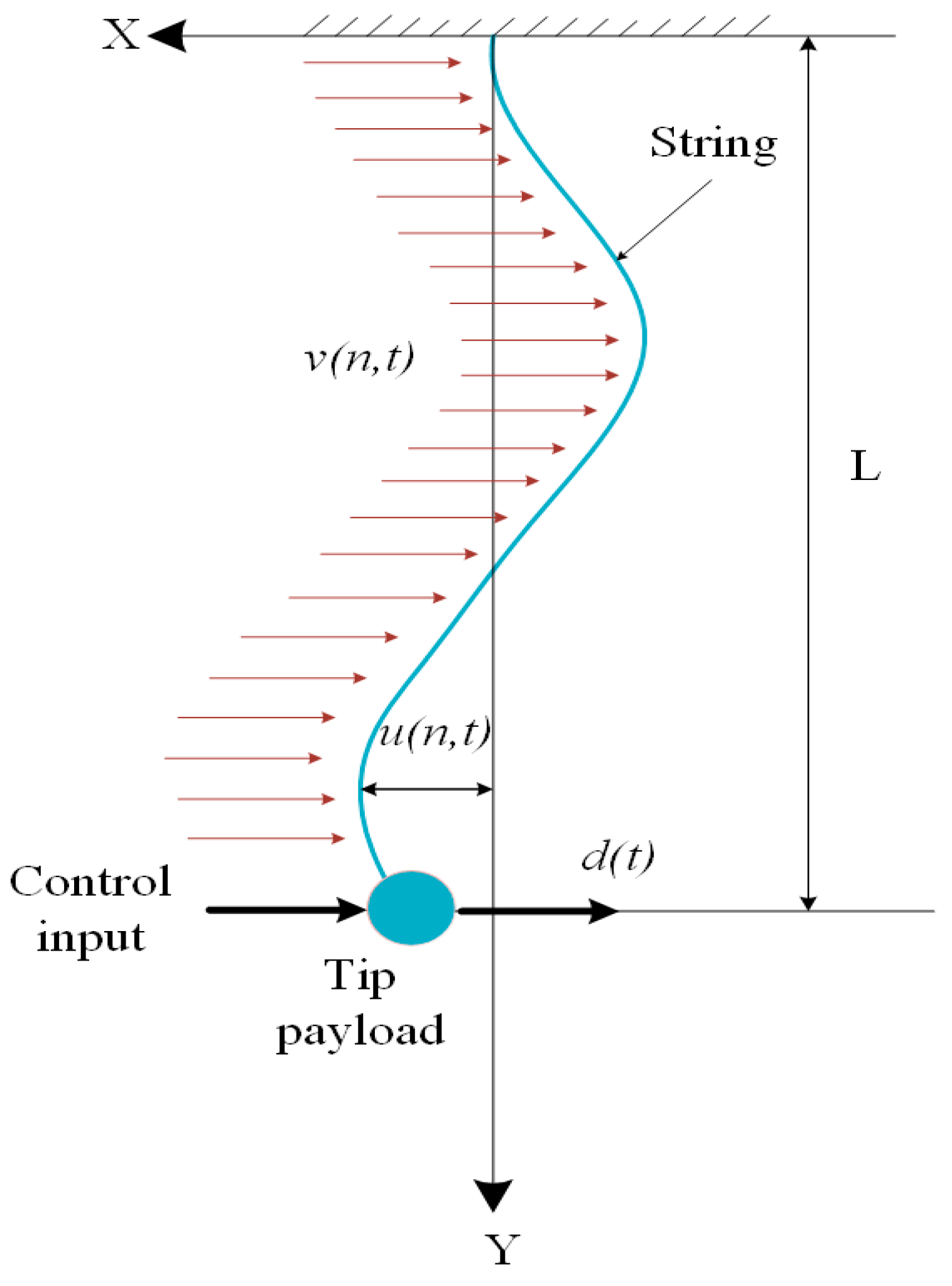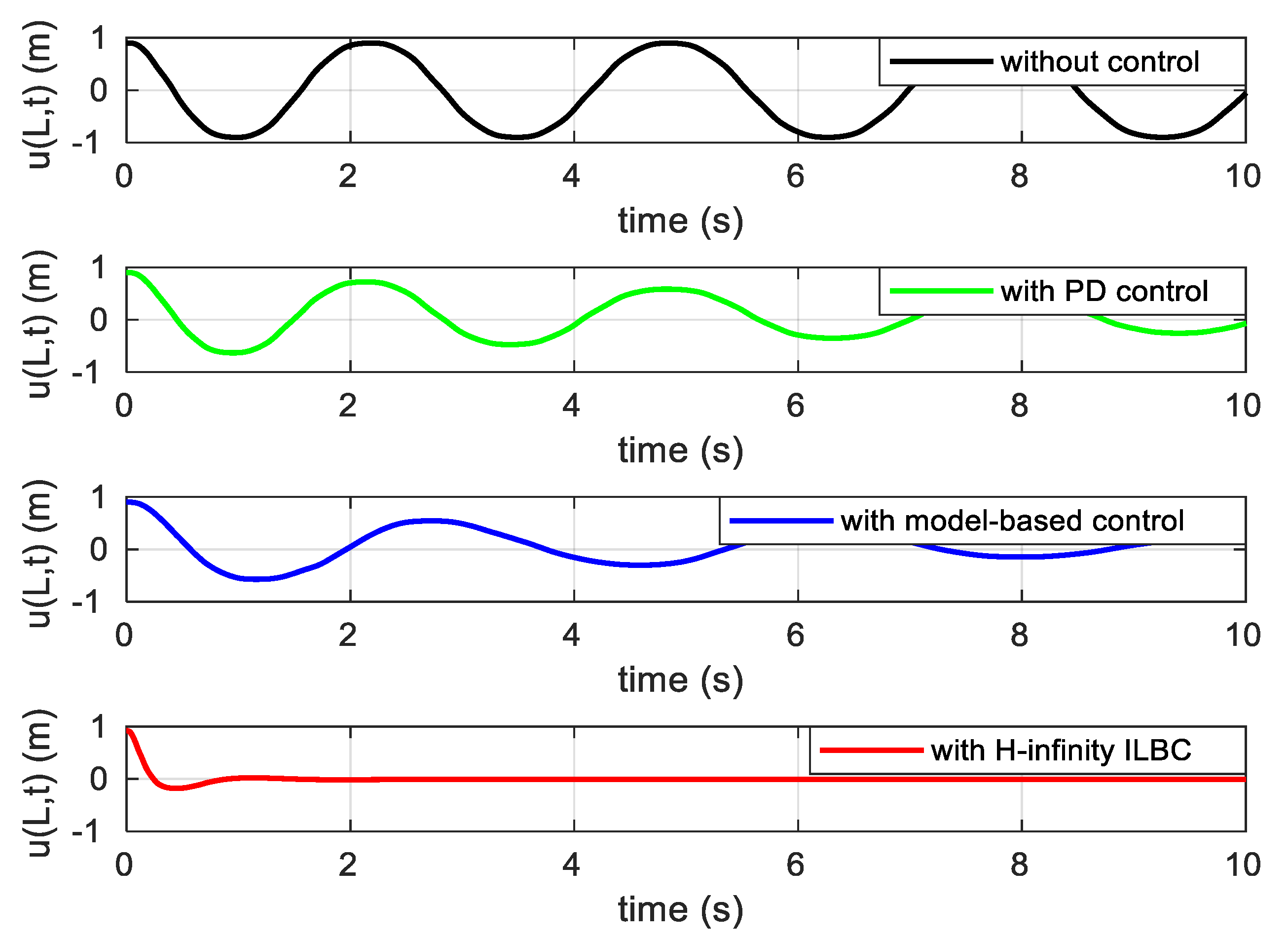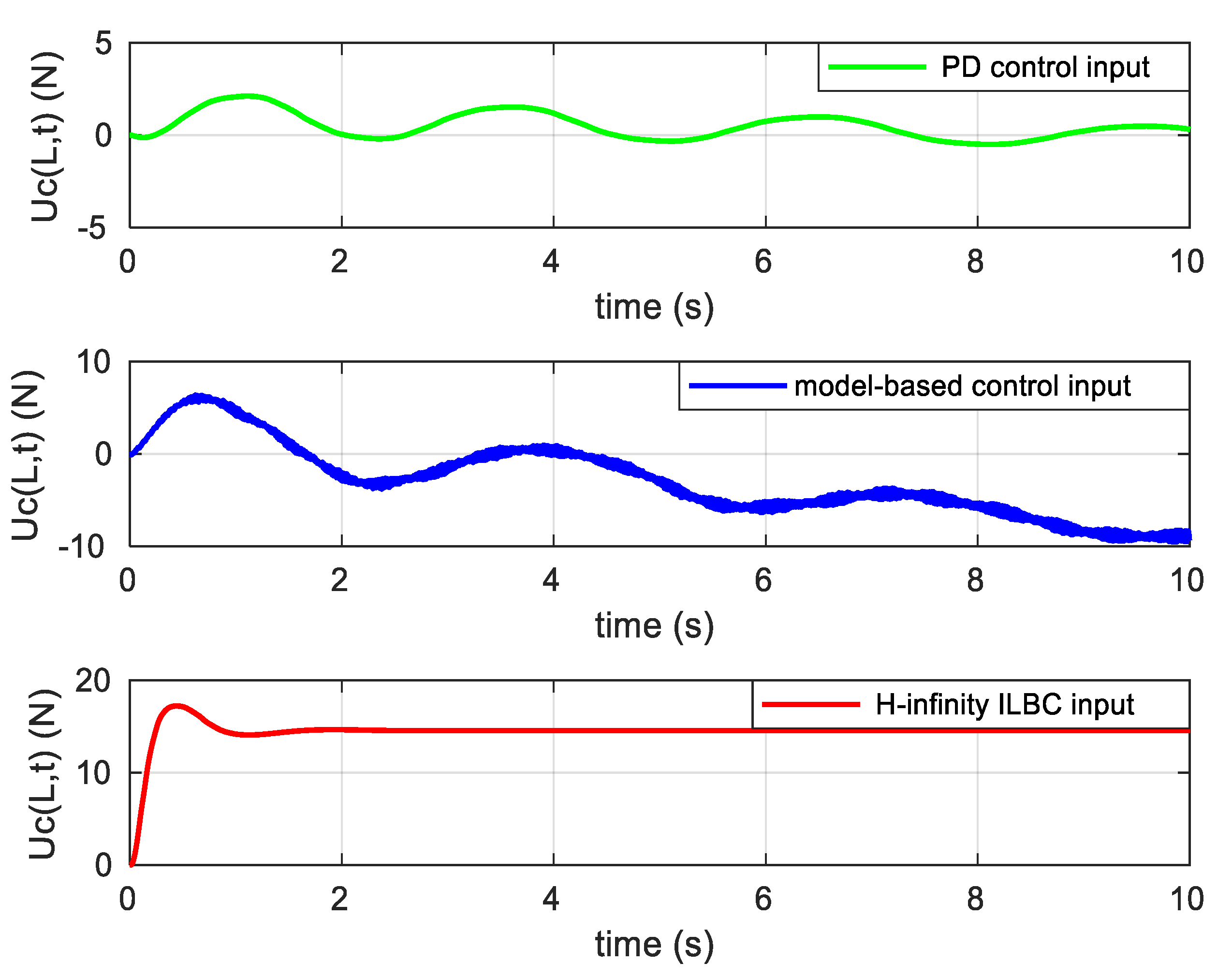H∞ Iterative Learning Boundary Vibration Control of Uncertain Vibrating String with Iteration-Varying Distributed Disturbance and Boundary Disturbance
Abstract
:1. Introduction
- An ILBC was proposed for the certain and uncertain DPS to diminish the vibrations in the presence of iteration-varying distributed/boundary disturbances.
- The dynamics of the vibrating string system in the form of a state-space system were obtained instead of a PDE system.
- An algebraic approach was employed to confirm that the ILBC is globally converging to equilibrium.
2. String System
Dynamics Model
3. Boundary Control Design
- How to deal with uncertainties: System parameters uncertainties have been discussed commonly by ILC for lumped parameters system (LPS). No study discusses the uncertainties for DPS through ILC.
- How to obtain the dynamic of a string system in the form of a state-space system: The approximated solution for string system has been addressed regularly by the FD method. To the authors knowledge, no studies achieve the dynamic of string system in the form of state-space by using MOL.
- How to overcome the outer disturbances: It is a challenge to acquire stability under distributed and boundary disturbances. Previous studies in ILC have overcome the external disturbances for LPS, but little consideration to achieve global convergence for string system under framework.
- How to propose the ILC formula for DPS: The string system is a function in time, position, and iteration. The ILC design is suggested to ensure the boundedness and robust stability of the close-loop string system in presence of the iteration parameter uncertainties, iteration-varying distributed disturbance and iteration boundary disturbance.
Stability Analysis
4. Results
- Without control: the certain vibrating string system was simulated under time-varying distributed disturbance in Equation (60), and boundary disturbance in Equation (61). The displacement of a certain string without control is shown in Figure 2, while the displacement deflection of the uncertain string without control is shown in Figure 3. It is clear that the deviations are considerably high for both cases.
- With proportional derivative (PD) control: the PD boundary control [42], acted on the certain and uncertain vibrating string with the control parameters and . The spatial time demonstration for certain and uncertain vibrating string system with PD control is shown in Figure 4 and Figure 5, respectively. It was obvious that the displacement of the uncertain string was extensive compared with the certain one. Which indicated that the PD controller was incapable of handling the vibrations of the uncertain vibrating string system.
- With model-based boundary control: the model-based boundary control , [42], acted on the certain and uncertain string with control parameter . The spatial time demonstration for certain and uncertain vibrating string system with model-based boundary control is shown in Figure 6 and Figure 7, respectively. It was evident that the displacement of the uncertain string was considerably large compared with the certain one, which indicated that the model-based boundary controller was also incapable of manipulating the vibrations of the uncertain vibrating string system. However, it was relatively better than the PD controller, as shown in Figure 5.
- With ILBC: the proposed ILBC (13) acts on the certain and uncertain string with and . The spatial time demonstration for a certain and uncertain vibrating string system with the proposed ILBC is shown in Figure 8 and Figure 9, respectively. It was evident that the displacement of the certain and uncertain string was damped effectively, which indicated that the ILBC law was capable of handling the vibrations of the uncertain vibrating string system, but it was relatively worse than the vibrations of the certain string which had no overshoot. Hence, this proposed control succeeded to handle the vibrations of the certain and uncertain string under iteration-varying distributed/boundary disturbances.
5. Discussion
6. Conclusions
Author Contributions
Funding
Conflicts of Interest
References
- Han, C.; Yan, T.; Tong, Y. The analysis on coupling vibration of drill string and marine riser in deep-water drilling. Int. J. Multiphysics 2016, 7. [Google Scholar] [CrossRef]
- He, W.; Ge, S.S. Cooperative control of a nonuniform gantry crane with constrained tension. Automatica 2016, 66, 146–154. [Google Scholar] [CrossRef]
- Suweken, G.; Van Horssen, W. On the transversal vibrations of a conveyor belt with a low and time-varying velocity. Part I: The string-like case. J. Sound Vib. 2003, 264, 117–133. [Google Scholar] [CrossRef]
- He, W.; Sun, C.; Ge, S.S. Top tension control of a flexible marine riser by using integral-barrier Lyapunov function. IEEE/ASME Trans. Mechatron. 2015, 20, 497–505. [Google Scholar] [CrossRef]
- Gunnarsson, S.; Norrlöf, M. Iterative Learning Control of a Flexible Mechanical System Using Accelerometers; Linköping University Electronic Press: Linköping, Sweden, 2000. [Google Scholar]
- Arif, M.; Ishihara, T.; Inooka, H. Experience-based iterative learning controllers for robotic systems. J. Intell. Robot. Syst. 2002, 35, 381–396. [Google Scholar] [CrossRef]
- Moore, K.L.; Chen, Y. On monotonic convergence of high order iterative learning update laws. IFAC Proc. Vol. 2002, 35, 19–24. [Google Scholar] [CrossRef]
- Zheng, L.; Tian, S.; Tian, H. A New Iterative Learning Control Algorithm for Distributed Parameter Systems. In Proceedings of the Chinese Control and Decision Conference, Guilin, China, 17–19 June 2009. [Google Scholar]
- Hao, S.; Liu, T.; Paszke, W.; Galkowski, K. Robust iterative learning control for batch processes with input delay subject to time-varying uncertainties. IET Control Theory Appl. 2016, 10, 1904–1915. [Google Scholar] [CrossRef]
- Meng, T.; He, W.; Huang, D.; Yang, L.J.; Sun, C. Iterative Learning Control for a Timoshenko Beam with Input Backlash. In Proceedings of the 6th Data Driven Control and Learning Systems (DDCLS), Chongqing, China, 26–27 May 2017. [Google Scholar]
- Zhu, Q.; Xu, J.X. Dual IM-based ILC scheme for linear discrete-time systems with iteration-varying reference. IET Control Theory Appl. 2017, 12, 129–139. [Google Scholar] [CrossRef]
- Huang, D.; Li, X.; He, W.; Zhang, S. Iterative learning control for boundary tracking of uncertain nonlinear wave equations. J. Frankl. Inst. 2018, 355, 8441–8461. [Google Scholar] [CrossRef]
- Xie, Y.; Tang, X.; Song, B.; Zhou, X.; Guo, Y. Iterative-learning integral-plus-proportional control of a flexible swing arm system for position trajectory tracking. Proc. Inst. Mech. Eng. Part C 2019, 233, 3769–3784. [Google Scholar] [CrossRef]
- Kouki, O.; Mnasri, C.; Toujeni, N.; Gasmi, M. H-Infinity based iterative learning control of systems with disturbances. Int. J. Eng. Res. Appl. 2013, 3, 1756–1763. [Google Scholar]
- Tayebi, A.; Abdul, S.; Zaremba, M.B.; Ye, Y. Robust iterative learning control design: Application to a robot manipulator. IEEE/ASME Trans. Mechatron. 2008, 13, 608–613. [Google Scholar] [CrossRef]
- Ahn, H.S.; Chen, Y.; Moore, K.L. Iterative learning control: Brief survey and categorization. IEEE Trans. Syst. ManCybern. Part C (Appl. Rev.) 2007, 37, 1099–1121. [Google Scholar] [CrossRef]
- Lu, J.; Cao, Z.; Zhang, R.; Gao, F. Nonlinear monotonically convergent iterative learning control for batch processes. IEEE Trans. Ind. Electron. 2017, 65, 5826–5836. [Google Scholar] [CrossRef]
- Lee, C.; Bristow, D.A.; Dong, J.; Alleyne, A.G.; Salapaka, S.M.; Ferreira, P.M.; Helfrich, B.E. Combined H∞-Feedback and Iterative Learning Control Design with Application to Nanopositioning Systems. In Proceedings of the American Control Conference, Seattle, WA, USA, 11–13 June 2008. [Google Scholar]
- Arimoto, S.; Kawamura, S.; Miyazaki, F. Bettering operation of robots by learning. J. Robot. Syst. 1984, 1, 123–140. [Google Scholar] [CrossRef]
- Bien, Z.; Huh, K.M. Higher-order iterative learning control algorithm. IEE Proc. D (Control Theory Appl.) 1989, 136, 105–112. [Google Scholar] [CrossRef]
- He, W.; Meng, T.; Zhang, S.; Liu, J.K.; Li, G.; Sun, C. Dual-loop adaptive iterative learning control for a Timoshenko beam with output constraint and input backlash. IEEE Trans. Syst. ManCybern. Syst. 2017, 49, 1027–1038. [Google Scholar] [CrossRef]
- He, W.; Meng, T.; Zhang, S.; Liu, J.K.; Li, G.; Sun, C. Iterative learning control for a class of mixed hyperbolic-parabolic distributed parameter systems. Int. J. Control Autom. Syst. 2016, 14, 1455–1463. [Google Scholar] [CrossRef]
- He, W.; Meng, T.; Huang, D.; Li, X. Adaptive boundary iterative learning control for an Euler–Bernoulli beam system with input constraint. IEEE Trans. Neural Netw. Learn. Syst. 2017, 29, 1539–1549. [Google Scholar] [CrossRef]
- Qiu, Q.; Luo, W.; Dai, X.; Lin, C. Iterative Learning Control for Nonlinear Distributed Parameter System with State Time Delay. In Proceedings of the IEEE International Conference on Information and Automation (ICIA), Yinchuan, China, 26–28 August 2013. [Google Scholar]
- Mejerbi, M.; Zribi, S.; Knani, J. Iterative Learning Control for Trajectory Tracking of Single-link Flexible Arm. Int. J. Adv. Comput. Sci. Appl. 2017, 8, 322–327. [Google Scholar] [CrossRef]
- Fu, Q.; Gu, P.; Wu, J. Iterative learning control for one-dimensional fourth order distributed parameter systems. Sci. China Inf. Sci. 2017, 60, 012204. [Google Scholar] [CrossRef]
- Zhang, L.; Liu, S. Iterative learning control for flexible manipulator using fourier basis function. Int. J. Autom. Comput. 2015, 12, 639–647. [Google Scholar] [CrossRef]
- Xu, C.; Arastoo, R.; Schuster, E. On Iterative Learning Control of Parabolic Distributed parameter Systems. In Proceedings of the 17th Mediterranean Conference on Control and Automation, Thessaloniki, Greece, 24–26 June 2009. [Google Scholar]
- Grebici, K.; Goh, Y.; McMahon, C. Uncertainty and Risk Reduction in Engineering Design Embodiment Processes. In Proceedings of the 10th International Design Conference, Dubrovnik, Croatia, 19–22 May 2008. [Google Scholar]
- Eden, M.R.; Siirola, J.D.; Towler, G. Proceedings of the 8th International Conference on Foundations of Computer-Aided Process Design; Elsevier: Amsterdam, The Netherlands, 2014; Volume 34. [Google Scholar]
- Liu, Z.; Liu, J.; He, W. An adaptive iterative learning algorithm for boundary control of a flexible manipulator. Int. J. Adapt. Control Signal Process. 2017, 31, 903–916. [Google Scholar] [CrossRef]
- Bu, X.; Cui, Z.; Cui, L.; Qian, W. Robust Quantized H∞ ILC Design for Uncertain Systems with Communication Constraints. Inf. Technol. Control 2018, 47, 564–574. [Google Scholar] [CrossRef]
- Moore, K.L.; Ahn, H.S.; Chen, Y.Q. Iteration domain H∞-optimal iterative learning controller design. Int. J. Robust Nonlinear Control 2008, 18, 1001–1017. [Google Scholar] [CrossRef]
- Mango, J.M.; Eryenyu, C.; Rugeihyamu, S.E. On finite differences on a string problem. J. Math. Stat. 2014, 10, 139–147. [Google Scholar] [CrossRef]
- Hyman, J.M. The Method of Lines Solution of Partial Differential Equations. Ph.D. Thesis, New York University, New York, NY, USA, October 1976. [Google Scholar]
- Vande Wouwer, A.; Saucez, P.; Schiesser, W.E. Simulation of distributed parameter systems using a Matlab-based method of lines toolbox: Chemical engineering applications. Ind. Eng. Chem. Res. 2004, 43, 3469–3477. [Google Scholar] [CrossRef]
- Shakeri, F.; Dehghan, M. The method of lines for solution of the one-dimensional wave equation subject to an integral conservation condition. Comput. Math. Appl. 2008, 56, 2175–2188. [Google Scholar] [CrossRef]
- He, W.; Zhang, S.; Ge, S.S. Adaptive control of a flexible crane system with the boundary output constraint. IEEE Trans. Ind. Electron. 2013, 61, 4126–4133. [Google Scholar] [CrossRef]
- He, W.; Ge, S.S. Vibration control of a flexible string with both boundary input and output constraints. IEEE Trans. Control Syst. Technol. 2014, 23, 1245–1254. [Google Scholar] [CrossRef]
- He, W.; Meng, T. Adaptive control of a flexible string system with input hysteresis. IEEE Trans. Control Syst. Technol. 2017, 26, 693–700. [Google Scholar] [CrossRef]
- Cavin, R.K., III; Tandon, S. Distributed parameter system optimum control design via finite element discretization. Automatica 1977, 13, 611–614. [Google Scholar] [CrossRef]
- Aguilar-Leal, O.; Fuentes-Aguilar, R.Q.; Chairez, I.; García-González, A.; Huegel, J.C. Distributed parameter system identification using finite element differential neural networks. Appl. Soft Comput. 2016, 43, 633–642. [Google Scholar] [CrossRef]
- He, W.; Ge, S.S. Robust adaptive boundary control of a vibrating string under unknown time-varying disturbance. IEEE Trans. Control Syst. Technol. 2011, 20, 48–58. [Google Scholar] [CrossRef]
- Yuan, L.; Achenie, L.E.; Jiang, W. Robust H∞ control for linear discrete-time systems with norm-bounded time-varying uncertainty. Syst. Control Lett. 1996, 27, 199–208. [Google Scholar] [CrossRef]















| Variable | Description |
|---|---|
| independent time variable | |
| independent position variable | |
| deflection of the string | |
| deflection angle of the string | |
| deflection angular velocity | |
| velocity of the string | |
| acceleration of the string | |
| time-varying distributed disturbance | |
| boundary disturbance | |
| string system density | |
| string tension | |
| string tip payload mass | |
| actual string length | |
| boundary control input | |
| position subdivision points | |
| time interval |
| Criteria | MOL | FD |
|---|---|---|
| Mathematical computation | Simple | Complex |
| Numerical stability | Stable | Considerably stable |
| Application for higher order system | Suitable | Relatively unsuitable |
| Setup time | Short | Long |
| Accuracy according to the final time rising | High | Poor |
| Accuracy according to the high step size | Relatively High | Poor |
| Accuracy according to the short length of string | Relatively High | Poor |
| Programming tool | Required | Not required |
| Parameter | Value |
|---|---|
| 1 m | |
| 0.1 kg/m | |
| 1 kg | |
| 10 |
© 2019 by the authors. Licensee MDPI, Basel, Switzerland. This article is an open access article distributed under the terms and conditions of the Creative Commons Attribution (CC BY) license (http://creativecommons.org/licenses/by/4.0/).
Share and Cite
Ahmed Eshag, M.; Ma, L.; Sun, Y.; Zhang, K. H∞ Iterative Learning Boundary Vibration Control of Uncertain Vibrating String with Iteration-Varying Distributed Disturbance and Boundary Disturbance. Appl. Sci. 2019, 9, 5122. https://doi.org/10.3390/app9235122
Ahmed Eshag M, Ma L, Sun Y, Zhang K. H∞ Iterative Learning Boundary Vibration Control of Uncertain Vibrating String with Iteration-Varying Distributed Disturbance and Boundary Disturbance. Applied Sciences. 2019; 9(23):5122. https://doi.org/10.3390/app9235122
Chicago/Turabian StyleAhmed Eshag, Mohamed, Lei Ma, Yongkui Sun, and Kai Zhang. 2019. "H∞ Iterative Learning Boundary Vibration Control of Uncertain Vibrating String with Iteration-Varying Distributed Disturbance and Boundary Disturbance" Applied Sciences 9, no. 23: 5122. https://doi.org/10.3390/app9235122





